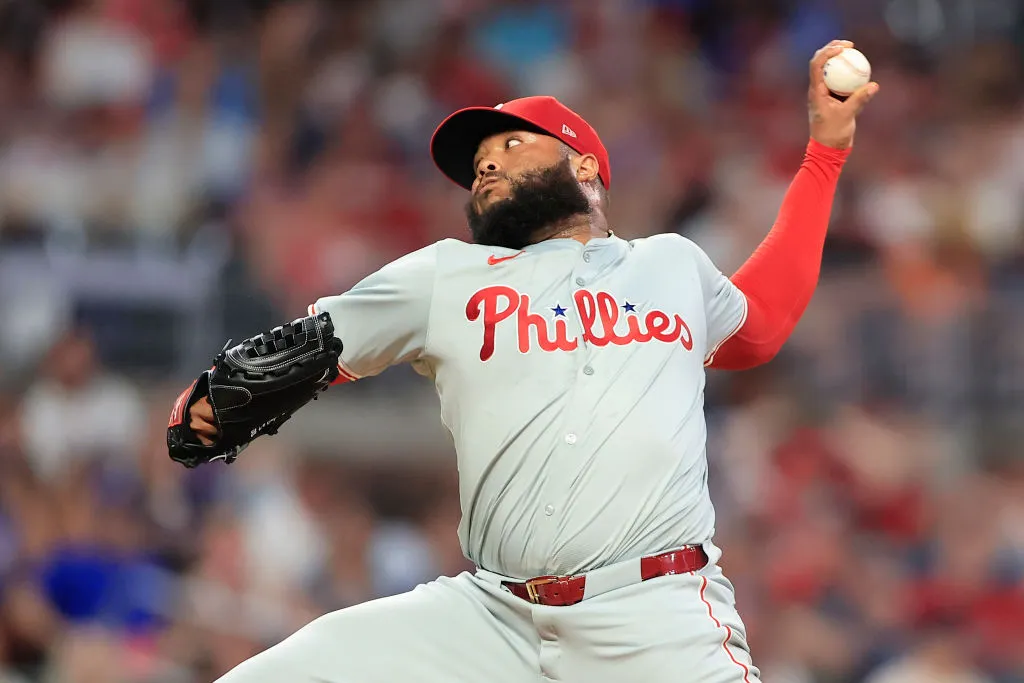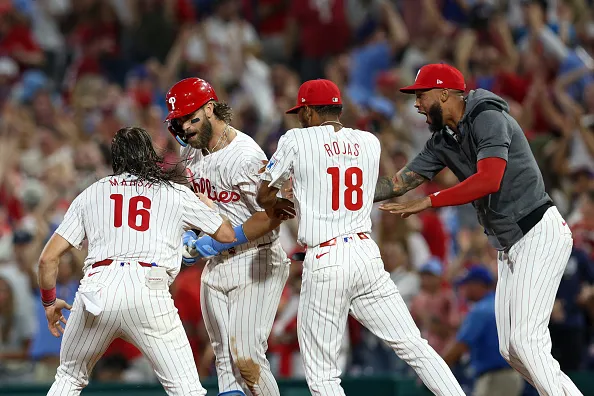For weeks leading up to the 2009 trade deadline, there was an almost audible buzz around the Phillies. Have you heard? The defending world champions are going to get right-hander Roy Halladay, one of the best pitchers out there, from the Blue Jays. Bet the ranch.
"I was so sure we were going to get him that I actually made up a uniform before we went to (San Francisco, the first series after the deadline)," director of team travel and clubhouse services Frank Coppenbarger recalled.
Sure enough, general manager Ruben Amaro Jr. pulled off a buzzer-beater by getting an American League Cy Young Award-winner 48 hours before time ran out.
Stay in the game with the latest updates on your beloved Philadelphia sports teams! Sign up here for our All Access Daily newsletter.
Except it was Indians left-hander Cliff Lee.
Halladay was Plan A and there's little doubt that would have worked out splendidly. But when that fell through, Amaro was able to pivot to what was, by any measure, the best deadline deal the Phillies have made in the last 25 years.
Their rotation was in tatters. Cole Hamels wasn't having nearly the success he had after being named both NLCS and World Series MVP the previous October. Jamie Moyer pitched his way out of the rotation and into the bullpen. Brett Myers missed three months following hip surgery.
The Phillies won eight of Lee's first 10 starts. But it was in the postseason that he really strutted his stuff. He won each of his first four starts, posting an 0.54 earned run average in the process, including a shutout in Game 1 of the World Series at Yankee Stadium. Even though the Phils came up short — partly because Lee gave up five runs in Game 5 — Amaro doubts the Phillies would have made it to World Series in back-to-back years for the only time in franchise history without him.
Philadelphia Phillies
"Could we have? Maybe. But probably not," he said, while also noting the contribution of Pedro Martinez, who pitched well after being lured out of retirement and joining the rotation in mid-August.
To get Lee, along with outfielder Ben Francisco, Amaro gave up RHPs Carlos Carrasco and Jason Knapp, SS Jason Donald and C Lou Marson. Only Carrasco, who is still with Cleveland, has had a notable big-league career. At the time it was Knapp who was considered most likely to succeed, but his career was derailed by injuries.
Why were the Phillies so convinced they were going to get Halladay instead?
"We wanted to send him to Philadelphia," said J.P. Ricciardi, then the Blue Jays general manager.
And why would they want to move a generational talent and face-of-the-franchise fan favorite?
Because Halladay was 32 years old and had never been to the postseason. He had signed an extension with the understanding that the payroll would be increased. Then upper management changed its mind.
Explained Ricciardi: "I just went to him, in complete honesty, and told him, 'We're probably going backwards. We're not going to win. I told you we were going to try to win and we did for two years. This isn't what you signed up for. So do you want to be traded? If you do, I'll do everything in my power to trade you. And tell me where you'd like to go and I'll try to do something that works out for us, too.'
"He said he'd like to go to Philadelphia because spring training was in Clearwater, right near his house. So I called Ruben and we started the ball rolling. I actually thought we were going to get something done."
Since the pitcher had a complete no-trade clause, his preferred destination was all that mattered.
So why didn't it happen?
In the end, Ricciardi found himself stuck between trying to respect Halladay's wishes and the need to get what he deemed proper value — C Travis d'Arnaud, RHP Kyle Drabek, OF Domonic Brown — in return. And Amaro was stuck between getting the player that he told club president Dave Montgomery shortly after he was promoted that, if he could get any player in baseball, it would be Halladay and knowing that he had a fallback position that was pretty darned attractive.
"Ruben wouldn't budge off one name," Ricciardi remembered.
"J.P. was pretty insistent on who he wanted," Amaro agreed.
By the time the winter meetings convened four-and-a-half months later, the Jays had replaced Ricciardi with Alex Anthopoulos. And he traded Halladay to the Phillies for a remarkably similar deal to what was on the table in July: D'Arnaud, Drabek and OF Michael Taylor.
Other significant Phillies trade deadlines:
July 30, 2006: RF Bobby Abreu and RHP Cory Lidle to Yankees for IF-OF C.J. Henry, RHP-C Jesus Sanchez, RHP Carlos Monasterios, LHP Matt Smith
Along with the next-day deal that sent reliever Rheal Cormier to the Reds for Justin Germano, this looked like a classic White Flag Salary Dump. General manager Pat Gillick basically admitted it. "Realistically, I think it would be a stretch to say we're going to be there in '07," the future Hall of Fame executive said at the time. "I don't want to mislead anyone. I think it's going to be a little slower."
By every shred of available evidence, Gillick should have been right. But the team promptly won 13 of its next 20 and was firmly in contention on August 21 when centerfielder Aaron Rowand broke his leg at Wrigley Field on a collision with second baseman Chase Utley while both were chasing a pop fly.
The best explanation is that the departure of so much service time created an opportunity for younger players like Jimmy Rollins, Chase Utley, Pat Burrell, Shane Victorino and others to assert themselves more.
Even without Rowand, the Phils ended up with 85 wins, just three games behind the Dodgers for the final wild-card spot. The following season, after shortstop Jimmy Rollins declared them the team to beat in the division, they won the first of five straight NL East titles.
July 27, 2007: Minor league pitcher Michael Dubee to White Sox for Tadahito Iguchi
Yes, the Phillies would go on to make the playoffs for the first time in 14 years. But on July 26, they were not only beaten by the Nationals to remain in third place, five games out, but they lost MVP candidate second baseman Chase Utley when a pitch from left-hander John Lannan broke a bone in his right hand. Surgery was required. Pundits opined that this could be the fatal blow to their October dreams.
The next day — the very next day — Gillick swung the deal for Iguchi. Utley ended up missing a month. In between, Iguchi batted .301 in 27 games with a .782 OPS. Given that the Phillies needed to finish with a rush to make up seven games against the Mets in the finals weeks and didn't clinch until the final day of the season, the importance of his ability to fill in so capably until Utley returned can't be overstated.
Many insiders later concluded that White Sox GM Kenny Williams was doing Gillick a favor because he felt bad about trading Freddy Garcia to the Phillies for pitchers Gio Gonzalez and Gavin Floyd the previous December; Garcia turned out to be damaged goods.
Fun fact: The player sent to Chicago's South Side is the son of then-Phillies pitching coach Rich Dubee.
July 31, 2015: LHP Cole Hamels with LHP Jake Diekman and cash to Rangers for C Jorge Alfaro, RHPs Jerad Eickhoff, Jake Thompson and Alec Asher, OF Nick Williams, LHP Matt Harrison
Amaro mentioned as an aside that there are some deals that come together quickly. "Then there are some that are five, six years in the making," he added. "Like the one I had with Texas for Hamels. I had been talking with (Rangers general manager Jon Daniels) for years."
The stars finally aligned in 2015. Hamels was still just 31 and pitching well. The previous season he had a 2.46 ERA and finished sixth in the Cy Young voting despite a 9-9 record which was largely due to lack of run support. The Phillies, on the other hand, were well on their way to 99 losses, those five straight division championships a rapidly fading memory.
At the time the trade was made, the general consensus was that the Phillies had done well under the circumstances. Alfaro, Williams and Thompson were all consensus Top 10 prospects for the organization. Ultimately, though, it didn't restock the system in the way Amaro might have hoped, even though Eickhoff made 76 starts for the team over five years and Williams had almost 1,000 plate appearances over three seasons.
Which doesn't mean it didn't turn out well. Four years later, then-general manager Matt Klentak packaged Alfaro and top pitching prospect Sixto Sanchez to get J.T. Realmuto from the Marlins.
July 26, 2000: RHP Curt Schilling to the Diamondbacks for RHPs Vicente Padilla and Nelson Figueroa, 1B Travis Lee, LHP Omar Daal
Schilling was one of the best starting pitchers in baseball. He was also 33 years old, and even though the team controlled his contract through 2001, was already making it clear that he wanted an extension a year early or he'd become a free agent and the Phillies would get nothing in return. He also had full no-trade approval.
With the Phillies lurching toward another last-place finish, general manager Ed Wade was backed into a corner. Compared to what Schill did for the rest of his career — 111 more wins, three second-place Cy Young finishes, championships with Arizona and Boston — the Phillies didn't get equal value in return, although Padilla and Figueroa had their moments.
Still, under the circumstances, Wade did as well as could be expected. Probably better.
1999: One That Got Away
In those less civilized days, the non-waiver trade window didn't shut until midnight. So after a loss to the Braves, several members of the traveling party stood in the visitor's clubhouse at Turner Field literally staring at the clock on the wall. Everybody was waiting to hear whether the Yankees had accepted the Phillies' offer of two former first-round draft choices, RHP Adam Eaton and OF Reggie Taylor, in exchange for 27-year-old LHP Andy Pettitte.
With less than 10 minutes to go, the Yankees called Wade on his cell phone to inform him that they'd decided to keep Pettite after all.
It was a little surprising that the pitcher was even being discussed, even though he was 7-8 with a 5.65 ERA at the time. Sources later confirmed what was suspected in the moment: It was impatient and impetuous owner George Steinbrenner who was pushing the idea and general manager Brian Cashman, manager Joe Torre and pitching coach Mel Stottlemyre who talked him off the ledge just in time.
Pettitte went on to win another 182 regular-season games in his career. He helped the Yankees make it to the World Series that year and the next two seasons as well.
And the unkindest cut of all: Ten years later he was the winning pitcher in both Game 3 and the clinching Game 6 of the 2009 World Series. Against the Phillies.


